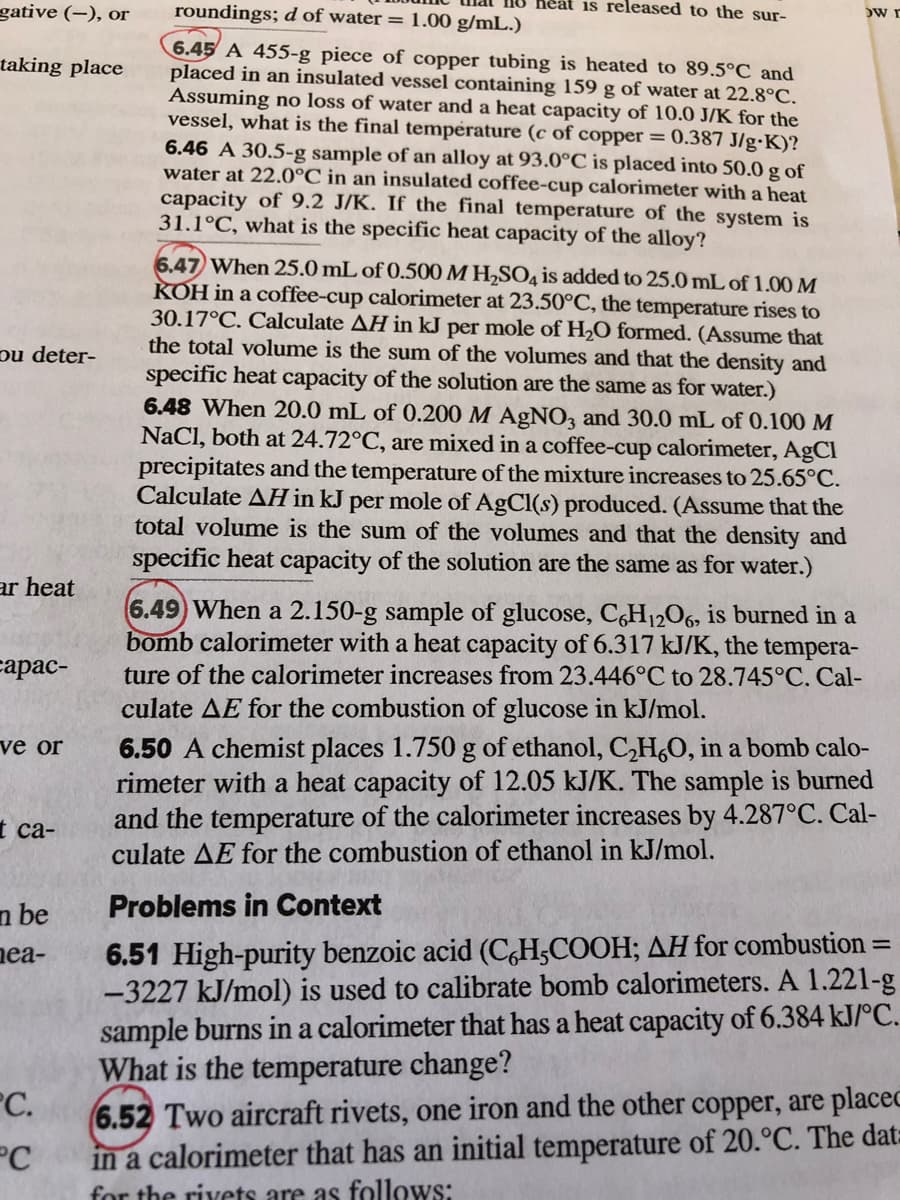at 6.49) When a 2.150-g sample of glucose, C,H12O6, is burned in a bomb calorimeter with a heat capacity of 6.317 kJ/K, the tempera- ture of the calorimeter increases from 23.446°C to 28.745°C. Cal- culate AE for the combustion of glucose in kJ/mol.
at 6.49) When a 2.150-g sample of glucose, C,H12O6, is burned in a bomb calorimeter with a heat capacity of 6.317 kJ/K, the tempera- ture of the calorimeter increases from 23.446°C to 28.745°C. Cal- culate AE for the combustion of glucose in kJ/mol.
Chemistry for Engineering Students
4th Edition
ISBN:9781337398909
Author:Lawrence S. Brown, Tom Holme
Publisher:Lawrence S. Brown, Tom Holme
Chapter9: Energy And Chemistry
Section: Chapter Questions
Problem 9.86PAE: 9.86 You make some iced tea by dropping 134 g of ice into 500.0 mL of warm tea in an insulated...
Related questions
Question
only 49

Transcribed Image Text:gative (–), or
roundings; d of water = 1.00 g/mL.)
Keat is released to the sur-
6.45 A 455-g piece of copper tubing is heated to 89.5°C and
placed in an insulated vessel containing 159 g of water at 22.8°C.
Assuming no loss of water and a heat capacity of 10.0 J/K for the
vessel, what is the final temperature (c of copper = 0.387 J/g•K)?
6.46 A 30.5-g sample of an alloy at 93.0°C is placed into 50.0 g of
water at 22.0°C in an insulated coffee-cup calorimeter with a heat
capacity of 9.2 J/K. If the final temperature of the system is
31.1°C, what is the specific heat capacity of the alloy?
taking place
6.47 When 25.0 mL of 0.500 M H,SO4 is added to 25.0 mL of 1.00 M
KOH in a coffee-cup calorimeter at 23.50°C, the temperature rises to
30.17°C. Calculate AH in kJ per mole of H2O formed. (Assume that
the total volume is the sum of the volumes and that the density and
specific heat capacity of the solution are the same as for water.)
6.48 When 20.0 mL of 0.200 M AGNO3 and 30.0 mL of 0.100 M
NaCl, both at 24.72°C, are mixed in a coffee-cup calorimeter, AgCl
precipitates and the temperature of the mixture increases to 25.65°C.
Calculate AH in kJ per mole of AgCl(s) produced. (Assume that the
total volume is the sum of the volumes and that the density and
specific heat capacity of the solution are the same as for water.)
ou deter-
ar heat
6.49) When a 2.150-g sample of glucose, C,H12O6, is burned in a
bomb calorimeter with a heat capacity of 6.317 kJ/K, the tempera-
eaрас-
ture of the calorimeter increases from 23.446°C to 28.745°C. Cal-
culate AE for the combustion of glucose in kJ/mol.
6.50 A chemist places 1.750 g of ethanol, C,H,O, in a bomb calo-
rimeter with a heat capacity of 12.05 kJ/K. The sample is burned
and the temperature of the calorimeter increases by 4.287°C. Cal-
culate AE for the combustion of ethanol in kJ/mol.
ve or
t ca-
n be
Problems in Context
6.51 High-purity benzoic acid (CH;COOH; AH for combustion :
-3227 kJ/mol) is used to calibrate bomb calorimeters. A 1.221-g
sample burns in a calorimeter that has a heat capacity of 6.384 kJ/°C.
What is the temperature change?
C.
nea-
6.52 Two aircraft rivets, one iron and the other copper, are placec
PC
in a calorimeter that has an initial temperature of 20.°C. The dat:
for the rivets are as follows:
Expert Solution
This question has been solved!
Explore an expertly crafted, step-by-step solution for a thorough understanding of key concepts.
This is a popular solution!
Trending now
This is a popular solution!
Step by step
Solved in 5 steps

Knowledge Booster
Learn more about
Need a deep-dive on the concept behind this application? Look no further. Learn more about this topic, chemistry and related others by exploring similar questions and additional content below.Recommended textbooks for you

Chemistry for Engineering Students
Chemistry
ISBN:
9781337398909
Author:
Lawrence S. Brown, Tom Holme
Publisher:
Cengage Learning

Chemistry: An Atoms First Approach
Chemistry
ISBN:
9781305079243
Author:
Steven S. Zumdahl, Susan A. Zumdahl
Publisher:
Cengage Learning

Principles of Modern Chemistry
Chemistry
ISBN:
9781305079113
Author:
David W. Oxtoby, H. Pat Gillis, Laurie J. Butler
Publisher:
Cengage Learning

Chemistry for Engineering Students
Chemistry
ISBN:
9781337398909
Author:
Lawrence S. Brown, Tom Holme
Publisher:
Cengage Learning

Chemistry: An Atoms First Approach
Chemistry
ISBN:
9781305079243
Author:
Steven S. Zumdahl, Susan A. Zumdahl
Publisher:
Cengage Learning

Principles of Modern Chemistry
Chemistry
ISBN:
9781305079113
Author:
David W. Oxtoby, H. Pat Gillis, Laurie J. Butler
Publisher:
Cengage Learning

Chemistry & Chemical Reactivity
Chemistry
ISBN:
9781337399074
Author:
John C. Kotz, Paul M. Treichel, John Townsend, David Treichel
Publisher:
Cengage Learning

Chemistry
Chemistry
ISBN:
9781305957404
Author:
Steven S. Zumdahl, Susan A. Zumdahl, Donald J. DeCoste
Publisher:
Cengage Learning
